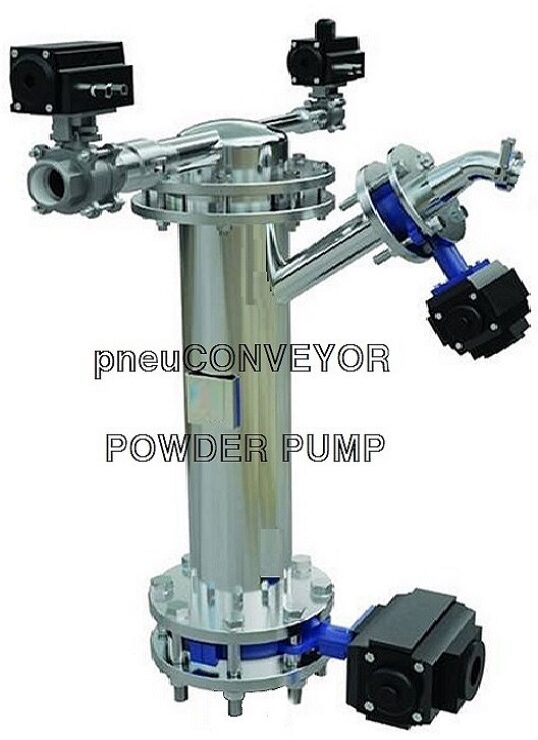What is Pneumatic Powder conveying system – A pneumatic powder conveying system is a method of transporting bulk powders or granular materials using compressed air or gas. It is commonly used in manufacturing and processing industries such as food, pharmaceuticals, and chemical production, where large quantities of powders need to be transported quickly and efficiently.


PNEUMATIC POWDER CONVEYING SYSTEM
In a pneumatic powder conveying system, a positive displacement blower or compressor is used to create a high-pressure air or gas flow. This flow is then directed through a pipeline or duct system, which carries the powders along with it. The powders are typically introduced into the airstream at a controlled rate through a feeder or injector.
The system relies on the force of the air or gas flow to suspend and carry the powders, which can be a significant challenge when dealing with materials that are cohesive or prone to settling. To address these issues, specialized equipment such as fluidizers, airlocks, and filters may be incorporated into the system to ensure consistent and reliable powder flow.
Pneumatic powder conveying systems offer several advantages over other methods of powder transport, such as conveyor belts or bucket elevators. They can handle a wider range of materials, are less prone to material degradation or contamination, and can transport powders over longer distances and at higher rates. However, they can also be more complex to design and operate, and require careful consideration of factors such as pipeline sizing, material properties, and system maintenance.
Pneumatic Powder conveying system working
A pneumatic powder conveying system is a type of material handling system used to transport powdered or granular materials through pipelines using compressed air or gas. The system typically consists of a feeding device, conveying pipeline, air compressor, and control system.
The working of a pneumatic powder conveying system involves the following steps:
- Feeding: The powdered or granular material to be conveyed is fed into a hopper or a silo using a screw feeder, vibratory feeder, or other similar devices.
- Conveying: Once the material is fed into the hopper or silo, it is transported through the pipeline using compressed air or gas. The pipeline is typically made of a material that is suitable for the conveyed material and can withstand the pressure and abrasion caused by the conveying process.
- Air compression: The compressed air or gas is supplied by an air compressor, which is responsible for generating the required pressure and flow rate for the conveying process.
- Control system: The control system ensures that the conveying process is running smoothly and safely. It monitors the pressure and flow rate of the compressed air or gas, regulates the feeding rate of the material, and detects any potential issues or blockages in the pipeline.
Overall, a pneumatic powder conveying system is an efficient and reliable way to transport powdered or granular materials in various industries such as food processing, pharmaceuticals, chemicals, and mining.
Pneumatic Powder conveying system advantages and
disadvantages
Pneumatic powder conveying systems are widely used in industries such as food processing, pharmaceuticals, and chemical manufacturing to transport powdered materials from one location to another. Here are some advantages and disadvantages of using such a system:
Advantages:
- Efficiency: Pneumatic conveying systems are very efficient, allowing materials to be transported quickly and with minimal loss.
- Flexibility: These systems can be designed to accommodate a variety of materials, including abrasive, fragile, and hygroscopic materials.
- Safety: Since the material is transported through a closed system, there is minimal risk of contamination or exposure to hazardous materials.
- Minimal manual labor: These systems require minimal manual labor, reducing the need for manual handling and thus, reducing the risk of injury to workers.
- Space saving: Pneumatic conveying systems are generally compact, requiring less floor space than other types of conveying systems.
Disadvantages:
- Cost: Pneumatic conveying systems can be expensive to install and maintain, especially if the system requires specialized components or controls.
- Energy consumption: These systems require a significant amount of energy to operate, which can result in high operating costs.
- Material degradation: The high velocity of the air used in pneumatic conveying can cause material degradation or separation, which can affect the quality of the end product.
- Noise pollution: Pneumatic conveying systems can be noisy, which can be a nuisance for workers in the vicinity.
- Maintenance requirements: These systems require regular maintenance to ensure proper functioning, which can add to the overall cost of operation.
Overall, pneumatic conveying systems offer a number of advantages for transporting powdered materials efficiently and safely, but also have some drawbacks that need to be considered before implementation.

